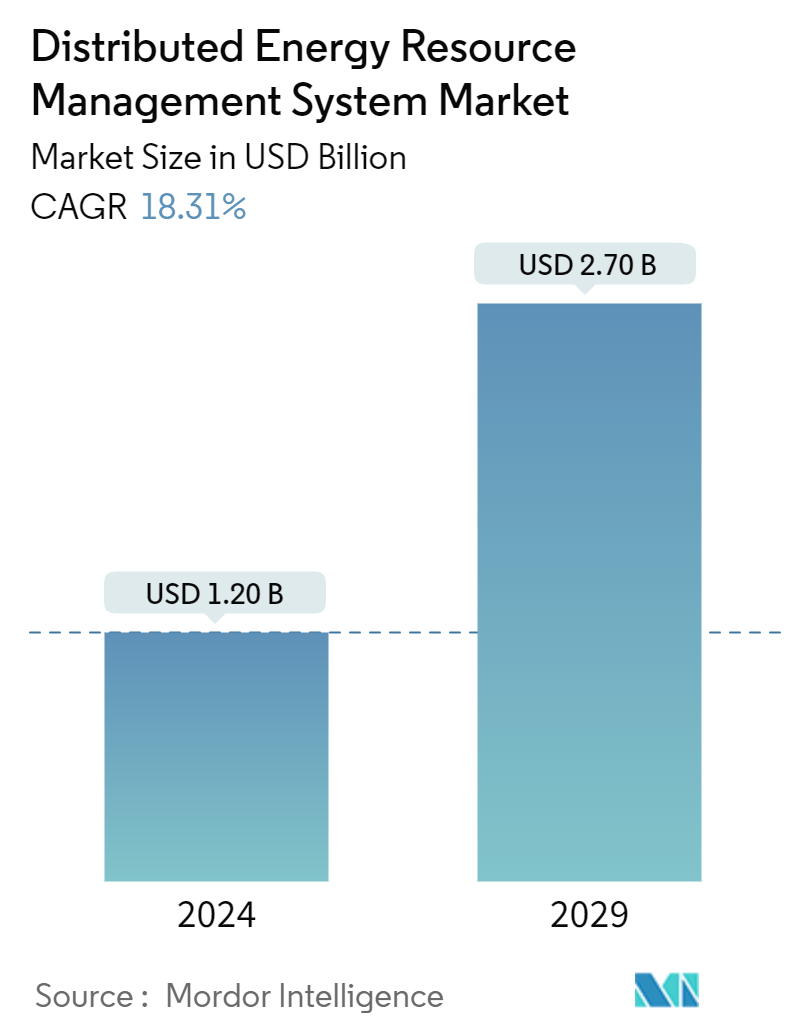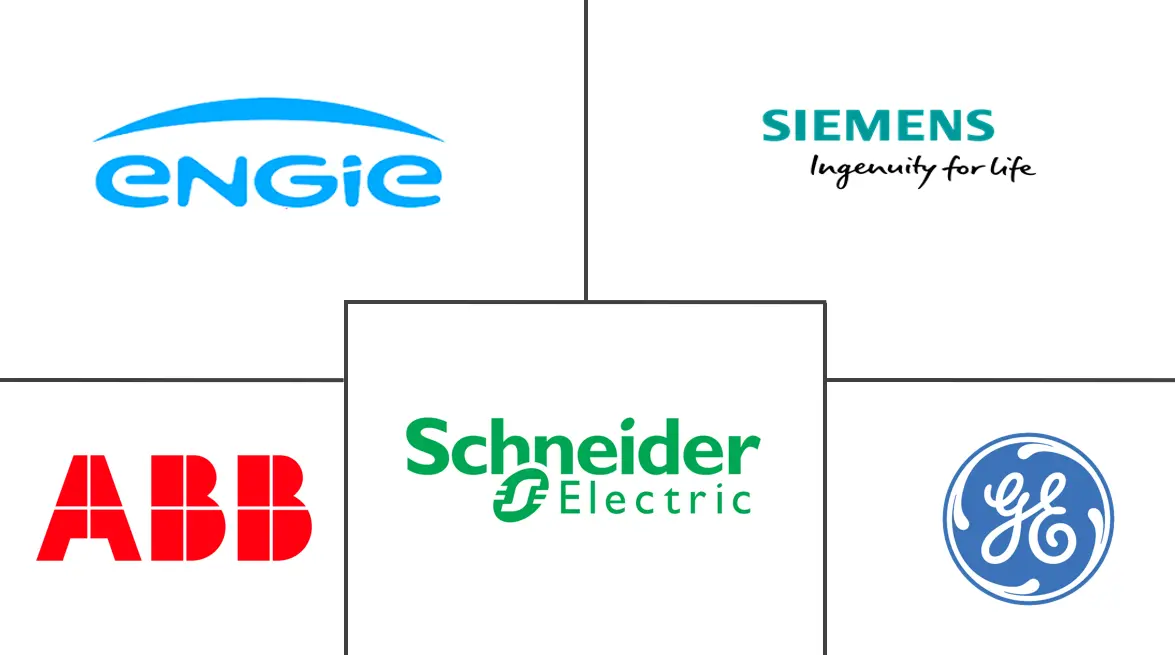Market Size of Distributed Energy Resource Management System Industry

| Study Period | 2019 - 2029 |
| Market Size (2024) | USD 1.20 Billion |
| Market Size (2029) | USD 2.70 Billion |
| CAGR (2024 - 2029) | 18.31 % |
| Fastest Growing Market | Asia Pacific |
| Largest Market | North America |
| Market Concentration | Medium |
Major Players
*Disclaimer: Major Players sorted in no particular order |
Distributed Energy Resource Management System Market Analysis
The Distributed Energy Resource Management System Market size is estimated at USD 1.20 billion in 2024, and is expected to reach USD 2.70 billion by 2029, growing at a CAGR of 18.31% during the forecast period (2024-2029).
- Over the medium term, factors such as an increasing shift toward renewables-based distributed power generation and rising investments in smart grid are expected to be some of the most significant drivers for the distributed energy resource management system (DERMS) market during the forecast period.
- On the other hand, there is a high initial cost of setting up DERMS. This may pose a threat to the distributed energy resource management system (DERMS) market during the forecast period.
- Nevertheless, the adoption of distributed power generation in the low-electrified areas of Asia-Pacific and Africa and the development of microgrids as a service are expected to act as opportunities in the market.
- North America is expected to be the largest market during the forecast period, owing to supportive government policies for distributed power generation technology and the increasing share of renewables in the energy mix.
Distributed Energy Resource Management System Industry Segmentation
A distributed energy resources management system (DERMS) is a platform that helps distribution system operators (DSO) manage their grids, which are primarily based on distributed energy resources (DER).
The distributed energy resource management system (DERMS) market is segmented by technology, end user, and geography. The market is segmented by technology into solar photovoltaic (PV), electric vehicles, microgrids, and other technologies. By geography, the market is segmented into North America, Europe, Asia-Pacific, South America, and Middle East and Africa. By end user, the market is segmented into industrial, residential, and commercial. The report also covers the market size and forecasts across major regions. For each segment, the market sizing and forecasts were made based on revenue (USD).
| By Technology | |
| Solar Photovoltaic (PV) | |
| Electric Vehicles | |
| Microgrids | |
| Other Technologies |
| By End User | |
| Industrial | |
| Residential | |
| Commercial |
| By Geography | |||||||
| |||||||
| |||||||
| |||||||
| |||||||
|
Distributed Energy Resource Management System Market Size Summary
The Distributed Energy Resource Management System (DERMS) market is poised for significant growth over the forecast period, driven by a shift towards renewable energy sources and increased investments in smart grid technologies. The market is expected to expand substantially, with North America leading due to supportive government policies and a growing share of renewables in the energy mix. Despite the high initial setup costs posing a challenge, opportunities arise from the adoption of distributed power generation in less electrified regions and the development of microgrids as a service. Solar photovoltaic (PV) systems, both rooftop and ground-mounted, are anticipated to be a major contributor to this growth, supported by decreasing installation costs and favorable government initiatives.
In North America, the DERMS market is expected to thrive, bolstered by the United States and Canada, which have a significant number of distributed generation units. The region's market growth is further supported by policies promoting solar energy adoption, such as tax credits and renewable portfolio standards. The increasing number of solar projects and the rise in electric vehicle adoption also contribute to the demand for DERMS. The market is semi-fragmented, with key players like General Electric, Siemens, ABB, Schneider Electric, and Engie playing significant roles. Recent trends in grid modernization and the expansion of renewable energy capacity globally provide additional momentum for the DERMS market, aligning with international goals for increased renewable energy generation.
Distributed Energy Resource Management System Market Size - Table of Contents
-
1. MARKET OVERVIEW
-
1.1 Introduction
-
1.2 Market Size and Demand Forecast, till 2029
-
1.3 Recent Trends and Developments
-
1.4 Government Policies and Regulations
-
1.5 Market Dynamics
-
1.5.1 Drivers
-
1.5.1.1 Increasing Shift Toward Renewables-based Distributed Power Generation
-
1.5.1.2 Rising Investments in Smart Grid
-
-
1.5.2 Restraints
-
1.5.2.1 Expansion and Upgradation of Centralized Grid
-
-
-
1.6 Supply Chain Analysis
-
1.7 Porter's Five Forces Analysis
-
1.7.1 Bargaining Power of Suppliers
-
1.7.2 Bargaining Power of Consumers
-
1.7.3 Threat of New Entrants
-
1.7.4 Threat of Substitute Products and Services
-
1.7.5 Intensity of Competitive Rivalry
-
-
-
2. MARKET SEGMENTATION
-
2.1 By Technology
-
2.1.1 Solar Photovoltaic (PV)
-
2.1.2 Electric Vehicles
-
2.1.3 Microgrids
-
2.1.4 Other Technologies
-
-
2.2 By End User
-
2.2.1 Industrial
-
2.2.2 Residential
-
2.2.3 Commercial
-
-
2.3 By Geography
-
2.3.1 North America
-
2.3.1.1 United States
-
2.3.1.2 Canada
-
2.3.1.3 Rest of North America
-
-
2.3.2 Europe
-
2.3.2.1 Germany
-
2.3.2.2 Italy
-
2.3.2.3 France
-
2.3.2.4 United Kingdom
-
2.3.2.5 Rest of Europe
-
-
2.3.3 Asia-Pacific
-
2.3.3.1 India
-
2.3.3.2 China
-
2.3.3.3 Japan
-
2.3.3.4 South Korea
-
2.3.3.5 Rest of Asia-Pacific
-
-
2.3.4 South America
-
2.3.4.1 Brazil
-
2.3.4.2 Argentina
-
2.3.4.3 Rest of South America
-
-
2.3.5 Middle East and Africa
-
2.3.5.1 United Arab Emirates
-
2.3.5.2 Saudi Arabia
-
2.3.5.3 Saudi Arabia
-
2.3.5.4 Rest of Middle East and Africa
-
-
-
Distributed Energy Resource Management System Market Size FAQs
How big is the Distributed Energy Resource Management System Market?
The Distributed Energy Resource Management System Market size is expected to reach USD 1.20 billion in 2024 and grow at a CAGR of 18.31% to reach USD 2.70 billion by 2029.
What is the current Distributed Energy Resource Management System Market size?
In 2024, the Distributed Energy Resource Management System Market size is expected to reach USD 1.20 billion.

